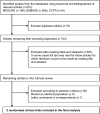Efficacy of oral iron therapy in improving the developmental outcome of pre-school children with non-anaemic iron deficiency: a systematic review
- PMID: 22894941
- PMCID: PMC10271588
- DOI: 10.1017/S1368980012003709
Efficacy of oral iron therapy in improving the developmental outcome of pre-school children with non-anaemic iron deficiency: a systematic review
Abstract
Objective: To systematically review the efficacy and safety of oral Fe therapy in pre-school children (1–5 years) with non-anaemic Fe deficiency, determined by children’s developmental and haematological status and the incidence of reported side-effects.
Design: A random-effects model was used to show mean differences with 95% confidence intervals of developmental and haematological scores between Fe-treated and non-treated groups.
Setting: MEDLINE, EMBASE, Cochrane library and bibliographies of identified articles were searched up to September 2011. Randomized and observational studies were assessed by two reviewers independently. Quality of the trials was assessed on the basis of concealment of allocation, method of randomization, masking of outcome assessment and completeness of follow-up.
Subjects: From the titles of 743 articles, full text review was completed on forty-six and two randomized trials of acceptable quality met the inclusion criteria. The two trials included a total of sixty-nine children.
Results: One study showed a statistically significant difference in the post-treatment Mental Developmental Index score among children who received oral Fe therapy v. no therapy (mean difference56?3, 95% CI 1?5, 11?0, P value not provided). Both studies showed significant improvement in serum ferritin level (mg/l: mean difference551? 1, 95% CI 33?6, 68?6, P,0?01 and mean difference517?1, 95% CI 7?5, 26?6, P value not provided, respectively) in children who received Fe therapy.
Conclusions: Evidence is insufficient to recommend oral Fe therapy to children with non-anaemic Fe deficiency. There is urgent need of conducting adequately powered, randomized trials examining the efficacy of oral Fe therapy in pre-school children with non-anaemic Fe deficiency.
Figures





References
-
- Tulchinsky TH & Vatavikova EA (2009) The New Public Health, 2nd ed. Burlington, MA: Elsevier Academic Press.
-
- World Health Organization/UNICEF/United Nations University (2001) Iron Deficiency Anaemia: Assessment, Prevention, and Control. A Guide for Programme Managers (WHO/NHD/01.3). Geneva: WHO.
-
- Yager JY & Hartfield DS (2002) Neurologic manifestations of iron deficiency in childhood. Pediatr Neurol 27, 85–92. - PubMed
-
- Grantham-McGregor S & Ani C (2001) A review of studies on the effect of iron deficiency on cognitive development in children. J Nutr 131, 2 Suppl. 2, 649S–668S. - PubMed
Publication types
MeSH terms
Substances
Grants and funding
LinkOut - more resources
Full Text Sources
Miscellaneous

